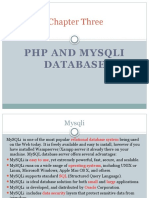0 ratings0% found this document useful (0 votes)
112 viewsPHP MySQL Insert Multiple Records
This document discusses how to insert multiple records into a MySQL database table at once using PHP. It shows an example of using the mysqli_multi_query() function to execute multiple INSERT SQL statements separated by semicolons. This inserts three new records into the "MyGuests" table with names and emails.
Uploaded by
Saripilli VasuCopyright
© © All Rights Reserved
Available Formats
Download as DOCX, PDF, TXT or read online on Scribd
0 ratings0% found this document useful (0 votes)
112 viewsPHP MySQL Insert Multiple Records
This document discusses how to insert multiple records into a MySQL database table at once using PHP. It shows an example of using the mysqli_multi_query() function to execute multiple INSERT SQL statements separated by semicolons. This inserts three new records into the "MyGuests" table with names and emails.
Uploaded by
Saripilli VasuCopyright
© © All Rights Reserved
Available Formats
Download as DOCX, PDF, TXT or read online on Scribd
You are on page 1/ 2
PHP
MySQL Insert Multiple
Records
❮ PreviousNext ❯
Insert Multiple Records Into MySQL Using
MySQLi and PDO
Multiple SQL statements must be executed with
the mysqli_multi_query() function.
The following examples add three new records to the "MyGuests" table:
Example (MySQLi Object-oriented)
<?php
$servername = "localhost";
$username = "username";
$password = "password";
$dbname = "myDB";
// Create connection
$conn = new mysqli($servername, $username, $password, $dbname);
// Check connection
if ($conn->connect_error) {
die("Connection failed: " . $conn->connect_error);
}
$sql = "INSERT INTO MyGuests (firstname, lastname, email)
VALUES ('John', 'Doe', 'john@example.com');";
$sql .= "INSERT INTO MyGuests (firstname, lastname, email)
VALUES ('Mary', 'Moe', 'mary@example.com');";
$sql .= "INSERT INTO MyGuests (firstname, lastname, email)
VALUES ('Julie', 'Dooley', 'julie@example.com')";
if ($conn->multi_query($sql) === TRUE) {
echo "New records created successfully";
} else {
echo "Error: " . $sql . "<br>" . $conn->error;
}
$conn->close();
?>
Note that each SQL statement must be separated by a semicolon.
You might also like
- An Example of Code To Insert Data To Database Using PHP MYSQLNo ratings yetAn Example of Code To Insert Data To Database Using PHP MYSQL2 pages
- FALLSEM2024-25 CSC1006 ELA VL2024250103522 2024-09-13 Reference-Material-INo ratings yetFALLSEM2024-25 CSC1006 ELA VL2024250103522 2024-09-13 Reference-Material-I4 pages
- Mysql Database:: How To Connect To DatabseNo ratings yetMysql Database:: How To Connect To Databse9 pages
- Notes Internet and Web Technology Iwt Unit 5No ratings yetNotes Internet and Web Technology Iwt Unit 518 pages
- Check Whether The Max Salary Exceding Upper LimitNo ratings yetCheck Whether The Max Salary Exceding Upper Limit2 pages
- PHP Mysqli Functions: Mysqli - Query, Mysqli - Connect, Mysqli - Fetch - ArrayNo ratings yetPHP Mysqli Functions: Mysqli - Query, Mysqli - Connect, Mysqli - Fetch - Array9 pages
- PHP Mysql Prepared Statements and Bound ParametersNo ratings yetPHP Mysql Prepared Statements and Bound Parameters3 pages



































































